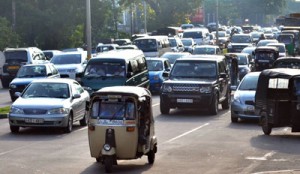New transportation plans promise exciting growth for Colombo
View(s):Colombo is on the verge of an imminent and exciting change. Until recently, the city has had to balance being both the commercial hub as well as being a place to live, grow, love and learn. If Sri Lankans wanted to lead a modern lifestyle they inevitably chose to settle down and raise families in one of Colombo’s inner-zones (where property prices are unaffordable to most) or immediate suburbs such as Nugegoda on the eastern side, Moratuwa outside the southern entrance to the city or Wattala towards the north.
Decades of this has meant that even these immediate suburban areas have reached a plateau in their respective development as residential centres; it is obvious that Colombo needed to grow beyond these immediate suburbs while, at the same time, integrating these areas even more deeply into Colombo’s infrastructural network and transport systems. It is against this context that the government has proposed the Rapid Transit System (RTS).
Consisting of a Light Rail Transport (LRT) to be used in conjunction with an electrified conventional railway system, reorganised bus routes, an inland water transport system, and a metropolitan expressway that would circle the city, the ambitious plans entail integrating these areas outside of Colombo’s immediate suburbs with the aim of widening the city’s residential hubs. These areas include Kadawatha, Kaduwela, Peliyagoda, Athurugiriya, Malabe and Kottawa. The implications of these areas entering Colombo’s ambit offers exciting opportunities – for families, for investors, and for businesses.
Faster transport times
Colombo’s traffic issues show no signs of abating in its current condition. Part of the issue on busy working days is the paradox of Colombo – many of those who work in Colombo do not live in the city as they constitute the migrant labour population (of between 1.5 and 2 million people) who come in every morning. Combined with an obsolete transport system and thousands of new vehicles coming into circulation monthly has made commuting an unpleasant experience.
The immediate benefit of the government’s plan to expand the road network and add modern transport modes into the equation for commuters will be seen in the outer suburban areas of Colombo. Malabe, for instance, will be among the first to see tangible change as it is the final destination in the LRT’s JICA line’s planned route from Fort. Once the LRT commences operations, travel times for residents in Malabe to the centre of the city are expected to be significantly lesser than taking existing commuting methods (close to an hour of commuting time saved is being forecast), whether it is a public transport system or a private vehicle. This benefit will make areas such as Malabe – currently affordable, but steadily rising in prices – increasingly valuable.
Property prices in greater suburban areas to rise
We alluded to this in the section above, but Malabe is not the only area that will benefit because of the LRT. Any town that falls into the LRT’s planned route will immediately see a rise in land and property values with a cascading effect that will be seen in other adjacent towns. At LankaPropertyWeb’s Research and Analytics Department, we have already seen prices in areas such as Battaramulla (20 per cent Y-o-Y increase), Malabe (16 per cent) and Rajagiriya (18 per cent) continue its steady rise in land value as the LRT project moves from conceptual stage to construction.
Modern lifestyle in the suburbs
The improvements to the transport and infrastructure around Colombo’s outer suburbs will have a knock-on effect on property developers too. Apartments and housing schemes are popping up fast in these areas, with developers keenly aware how attractive areas such as Malabe and Athurugiriya are developing.
Approximately 170 property developments, accounting for around 40 per cent of overall property development, is concentrated in these outer suburbs of Colombo.

File picture of traffic in Colombo
Housing won’t be the only tangible impact: schools (state, private and international), hospitals, shopping centres, and restaurants are fast becoming the norm in these greater suburbs. What that means is that any Sri Lankan family wanting to live a modern lifestyle – with all modern amenities and facilities that you would expect living in Colombo – can do without having to commute for long periods between inner Colombo and its outer suburbs. These areas, due to their semi-rural routes, have always afforded families more greenery, less noise pollution and traffic as highly attractive reasons to settle there. With the new developments in transport and roads, more families will even be more justified in choosing to move out of Colombo and into these suburban areas.
More opportunities for trade
The planned expressways, including the Outer Colombo Highway, will connect, until now disconnected parts of the island in exciting new ways. For instance, the Outer Colombo Highway will connect to the Southern Expressway, the Colombo-Katunayake Expressway, the new Kandy Road, and the Northern Expressway. In theory, this removes many of the obstacles that prevent businesses from the relatively rural parts of the country from doing business with one another.
Conclusion
The next 10 years will see Colombo change in profound ways. Though most of us associate these changes with Colombo’s skyline, there is a significant change happening down at the street level. These changes will alter Colombo tangibly, but more importantly it will change the way Sri Lankans look at the commercial capital of Sri Lanka.
(The writer is Managing Director of Lanka Property Web (Pvt) Ltd and can be reached at daham@lpw.lk)


